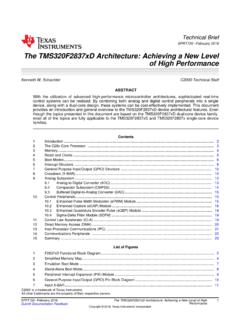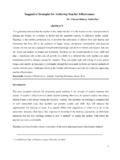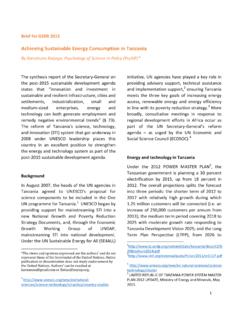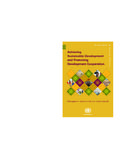Transcription of ACHIEVING INCLUSIVE GROWTH IN THE FACE OF DIGITAL ...
1 1 ACHIEVING INCLUSIVE GROWTH IN THE FACE OF DIGITAL TRANSFORMATION AND THE FUTURE OF WORK OECD report to G-20 Finance Ministers 19 March 2018 Key messages Rapid innovation is reshaping the way goods and services are produced and consumed, with profound implications for the dynamics of productivity, jobs, trade and investment. Emerging technologies have potential to bring considerable economic benefits but entail disruptive adjustments and require ambitious policies for the future world of work. The confluence of technological breakthroughs such as DIGITAL technologies, 3D printing, bio-based production, nanomaterials will transform the production and distribution of goods and services over the next 10 to 15 years. These technologies can bring large productivity gains, but this will require technology adoption and diffusion to accelerate, with complementary investments in workers and organisational skills and framework conditions that are conducive to experimentation and competition.
2 Emerging economies face particular uncertainties as new technologies may challenge the traditional development path. However, they can also have opportunities to leapfrog dependent on scaling up technology adoption and building the necessary talent pool and DIGITAL infrastructure. Automation has so far not created massive job losses, but does lead to reallocations of employment between tasks, sectors and regions. Technological change shifts labour demand towards more cognitive skills for which many current workers are not adequately trained, contributing to the polarisation of the labour market and the hollowing out of middle-skill jobs. To help workers adapt and gain from the DIGITAL transformation, policies should focus on investing in skills at all levels, especially life-long learning, supporting transitions to new jobs, and adapting social protection systems and labour market institutions to new forms of work. Structural policies should also facilitate innovation and entrepreneurship to foster innovation and technology diffusion, ensure that competitive conditions prevail and avoid erecting barriers to cross-border DIGITAL markets.
3 Rising interconnectedness calls for international dialogue in the design of policies for the future world of work in areas such as taxation, competition, R&D incentives and standard-setting. This report first reviews the main trends in new technologies and their effects on productivity, business models and GROWTH . It provides an overview of the implications of transformative innovations for the future of work, jobs and skills, before drawing the main policy implications. 2 New technologies will have major impacts on future employment, productivity and incomes The path of the global economy is undergoing significant changes in the rate and composition of productivity GROWTH , investment and employment gains since the crisis, including from digitalisation and globalisation, with potential for large economic gains but also major reallocation of activity between sectors and countries. This note focuses on the current and future impacts of technological change itself, keeping in mind that it could amplify or mitigate the effects of other ongoing megatrends , including global economic integration as well as demographic and environmental challenges.
4 Digitalisation and technological innovations are changing the nature of production A confluence of new technologies are already transforming the production and distribution of goods and services. Rapidly evolving technologies create considerable opportunities for productivity GROWTH and improvements in well-being; but they also create considerable challenges for skills, employment, productivity diffusion and income distribution. Among the main emerging technologies (Box 1; OECD, 2016a; OECD, 2017a): DIGITAL technologies and data-driven innovation, based on big data analytics, increasingly permit machine functionalities that rival human performance in tasks such as pattern recognition. Cloud computing and the Internet of Things enable the development of autonomous machines and intelligent systems. Robots are set to become less costly, smaller, more intelligent, autonomous, and agile. Bio-based production brings the life sciences closer to engineering.
5 This has already transformed the chemicals industry and could bring new solutions to dependence on oil and petrochemicals. Nanotechnology, through which new properties are being imparted to materials, makes them stronger, lighter, more electrically conductive, more versatile, etc. 3D printing has potential to revolutionise vast segments of manufacturing from mass production to customisation and already permits printing of complex objects made from different materials. Most of these technologies have not yet reached widespread industrial application. The diffusion of new innovations tends to be S shaped , with few early adopters followed by a rapid wave of adoption. Some innovations are reaching households at increasing speed: for instance, it took 35 years for a quarter of the US population to use the telephone after it was invented and 15 years for the personal computer, but only 7 years for the internet and 4 years for the smartphone.
6 But, the adoption of new technologies by firms remains uneven. This suggests that we may be at the cusp of a new era of radical transformation if the take-up of new technologies rapidly expands beyond pioneering firms, but there is high uncertainty about the evolution of technology itself and how quickly and widely innovations will be put to commercial use. 3 Box 1. Disruptive production technologies Many technological breakthroughs will disrupt the way goods and services are produced and distributed over the next 10 to 15 years, requiring potentially radical adaptation in business models, skills systems and policies. New advances in DIGITAL technologies, data science, new materials are already used in production and more transformational technologies are on the horizon in a range of industries (OECD, 2016a; OECD, 2017a). The Internet of Things (IoT) is spreading rapidly and promises a hyper-connected, digitally responsive society. By 2030, it is estimated that 8 billion people and maybe 25 billion active smart devices will be interconnected and interwoven in one huge information network (OECD, 2015d).
7 The largest impacts are expected in healthcare, manufacturing (with sensors enabling comprehensive supply chain intelligence) and network industries. According to Vodafone (2015), the IoT reduces industrial costs among industrial adopters by 15% on average. How fast and how effectively the IoT will evolve over the next 15 years depends to a large extent on the roll-out of fixed and mobile broadband and the decreasing cost of devices, as well as on the ability of businesses to build data analytics capacity. Big data analytics is a set of techniques and tools to process and interpret large volums of data, including data mining, profiling, business intelligence, machine learning and visual analytics. The exploitation of big data, in combination with sensors and the IoT, will become a key determinant of innovation and competitiveness for individual firms. It allows firms to closely monitor and optimise their operations, not only by gathering large volumes of data on their production processes or service delivery, but also on how customers approach them and place orders, allowing them to eliminate errors, reduce inventories and speed up delivery.
8 It also provides consumers with more personalised products and services that are specifically tailored to their needs. Firm-level evidence suggests that using data-driven innovation can raise labour productivity by 5 to 10% relative to non-users (OECD, 2015d). Artificial intelligence (AI) refers to the ability of machines and systems to perform a broad variety of cognitive tasks, such as sensing, processing oral language, learning, making decisions and manipulating objects accordingly using a combination of big data analytics, cloud computing, IoT and machine-to-machine communication. AI is expanding the roles of robots, which have been traditionally limited to monotonous tasks requiring speed, precision and dexterity; more autonomous and agile AI-enabled robots are set to become increasingly central to logistics and manufacturing. Sectors that are likely to experience radical transformations include agriculture, chemicals, oil and coal, rubber and plastics, shoe and textile, transport, construction, defence, and surveillance and security.
9 For instance, autonomous drill rigs could increase mining productivity by 30% to 60% (Citigroup-Oxford Martin School, 2015). AI will also be increasingly deployed in a wide range of services including entertainment, medicine, marketing and finance. Nanomaterials display unique optical, magnetic and electrical properties that can be exploited in various fields, from healthcare to textile ( smart fabrics ), construction (functional building materials such as self-cleaning concretes) and energy technologies. Areas of application already encompass medicine, imaging, energy and hydrogen storage, catalysis, lightweight construction and UV protection, and the spectrum of commercially viable applications is expected to increase over the next few years. However, both the development of nanomaterials and their commercialisation have expanded much more slowly than initially anticipated in the 1980s. Technical constraints and uncertainties over their toxicity to humans and the environment continue to hinder the development of cost-effective, large-scale commercial applications of nanomaterials.
10 Synthetic biology draws on engineering principles to manipulate genetic materials in living organisms. It allows for the design and construction of new biological parts and the re-design of natural biological systems. It is expected to have a wide range of applications in energy ( relatively low-cost transport fuels), medicine ( vaccine development), agriculture ( engineered plants) and chemicals (bio-based production of new materials), but it also raises major legal and ethical issues. 3D printing or additive manufacturing encompasses different techniques that build products by adding material in layers, often using computer-aided design software. 3D-printing processes are primarily used for rapid prototyping, models and tools. More recently, as materials, accuracy and the overall quality of the output have improved, 3D printing has widened its scope of application. The technology allows for design flexibility, the personalisation of highly complex samples and components, reduced waste, and can remove the need for assembly in some stages of production.

















